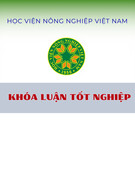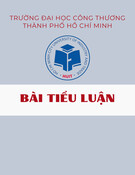
RESEARC H Open Access
Detection of carcinoembryonic antigen
messenger RNA in blood using quantitative
real-time reverse transcriptase-polymerase chain
reaction to predict recurrence of gastric
adenocarcinoma
Miao-zhen Qiu
1,2
, Zhuang-hua Li
1,2
, Zhi-wei Zhou
1,3
, Yu-hong Li
1,2
, Zhi-qiang Wang
1,2
, Feng-hua Wang
1,2
,
Peng Huang
4*
, Fahad Aziz
5
, Dao-yuan Wang
6
, Rui-hua Xu
1,2*
Abstract
Background: The existence of circulating tumor cells (CTCs) in peripheral blood as an indicator of tumor
recurrence has not been clearly established, particularly for gastric cancer patients. We conducted a retrospective
analysis of the relationship between CTCs in peripheral blood at initial diagnosis and clinicopathologic findings in
patients with gastric carcinoma.
Methods: Blood samples were obtained from 123 gastric carcinoma patients at initial diagnosis. mRNA was
extracted and amplified for carcinoembryonic antigen (CEA) mRNA detection using real-time RT-PCR. Periodic
3-month follow-up examinations included serum CEA measurements and imaging.
Results: The minimum threshold for corrected CEA mRNA score [(CEA mRNA/GAPDH mRNA) × 10
6
] was set at
100. Forty-five of 123 patients (36.6%) were positive for CEA mRNA expression. CEA mRNA expression significantly
correlated with T stage and postoperative recurrence status (P= 0.001). Recurrent disease was found in 44 of 123
cases (35.8%), and 25 of these (56.8%) were positive for CEA mRNA. Of these patients, CEA mRNA was more
sensitive than serum CEA in indicating recurrence. Three-year disease-free survival of patients positive for CEA
mRNA was significantly poorer than of patients negative for CEA mRNA (P< 0.001). Only histological grade and
CEA mRNA positivity were independent factors for disease-free survival using multivariate analysis.
Conclusions: CEA mRNA copy number in peripheral blood at initial diagnosis was significantly associated with
disease recurrence in gastric adenocarcinoma patients. Real-time RT-PCR detection of CEA mRNA levels at initial
diagnosis appears to be a promising predictor for disease recurrence in gastric adenocarcinoma patients.
Background
Gastric cancer remained the leading cause of cancer
mortality worldwide throughout the 20th century. The
only proven curative treatment is surgical resection of
all gross and microscopic lesions. However, despite
undergoing curative gastrectomy, including extended
lymph node dissection and adjuvant chemotherapy, can-
cer recurs in both regional as well as distant sites in
majority of the patients [1]. Diagnosis of recurrence
with common follow-up protocols usually is made at a
late stage, which, to an extent, precludes the possibility
of effective treatment [2]. Surveillance of circulating
tumor cells (CTCs) seems to offer greater possibility for
earlier diagnosis of recurrent disease.
The concept of investigating the metastatic process in
peripheral blood originated in the 19th century when
T.R. Ashworth first described the phenomenon of
* Correspondence: phuang@mdanderson.org; xurh@sysucc.org.cn
1
State Key Laboratory of Oncology in South China, Guangzhou 510060,
China
4
Department of Molecular Pathology, The University of Texas, MD Anderson
Cancer Center. USA
Full list of author information is available at the end of the article
Qiu et al.Journal of Translational Medicine 2010, 8:107
http://www.translational-medicine.com/content/8/1/107
© 2010 Qiu et al; licensee BioMed Central Ltd. This is an Open Access article distributed under the terms of the Creative Commons
Attribution License (http://creativecommons.org/licenses/by/2.0), which permits unrestricted use, distribution, and reproduction in
any medium, provided the original work is properly cited.

CTCs, and S. Paget hypothesized a non-random pattern
of cancer metastasization (the ‘seed and soil’theory)
[3,4]. Subsequently, the malignant nature of CTCs was
confirmed by demonstrating that they possess tumor-
specific chromosomal aberrations [5,6] and that they
grow ex vivo as cell lines with a malignant phenotype
[7]. Several approaches to detect CTCs have been
described and can be classified into PCR-based methods
and cytometric methods [8].
With the advent of quantitative real-time PCR techni-
ques [9], precise quantification of a target sequence has
become possible. Quantitative PCR provides investiga-
tors not only with technical advantages, but also with
applicative advantages, such as the definition of cutoff
values indicating mRNA expression levels of clinical
relevance in cancer patients compared with healthy sub-
jects. Real-time PCR also affords the possibilities of cor-
relating target-sequence load with clinical outcome [10]
or response to therapy [11].
CEA, originally described as a tumor-associated colon
cancer antigen, was cloned in 1987 and is now recog-
nized as a member of the immunoglobulin protein
superfamily [12]. Many studies have reported detection
of gastric cells in blood [13], bone marrow [14], and
peritoneal washing [15] of gastric cancer patients by
using real-time PCR for CEA mRNA.
The goal of this study was to evaluate the effectiveness
of the CEA mRNA real-time PCR technique for the
early detection of tumor recurrence. To meet this goal,
the relationship between clinical recurrence and blood
levels of CEA mRNA preoperatively was examined in
gastric adenocarcinoma patients.
Methods
Patients
Written informed consent was obtained from every
patient on the use of blood samples for research in
accordance with the institutional guidelines of our hos-
pital. Between February 2002 and December 2006, a
total of 123 consecutive patients with gastric adenocarci-
noma at Cancer Center of Sun Yat-sen University were
enrolled into this study. All patients received radical
resection and D2 lymphadenectomy. At lease 15 lymph
nodeswereavailableforthedetection.Noperitoneal
dissemination was found. Clear records of serum CEA
change and imaging evaluation before the operation and
every three months after the operation were required.
Patients who had positive lymph node were recom-
mended to receive adjuvant chemotherapy but finally
only eighty-three patients underwent adjuvant che-
motherapy. The regimens included CAPOX (Capecita-
bine + Oxaliplatin, 16 cases, with a median cycle of 4),
folfox6 (56 cases, with a median cycle of 6), taxol + cis-
platin (4 cases, with a median cycle of 4), taxol + 5FU/
CF (Fluorouracil/Leucovorin, 7 cases, with a median
cycle of 6). Recurrent disease, including local relapse
and distant metastases, was detected by computed
tomography examination. New lesions detected by ima-
ging examination in follow-up appointments were
regarded as recurrence. Biopsy was not done routinely
to determine histological recurrence. All imaging was
evaluated by at least two independent observers, includ-
ing radiologists. The median follow-up period was 37.0
months (range, 3.0-73.6 months).
Blood samples
Blood samples were collected at initial diagnosis one or
two days before surgery. The first 3 mL of blood was
discarded to prevent epidermal contamination, and
then a 5-mL blood sample was obtained from the per-
ipheral vein. Peripheral blood samples obtained from
30 non-cancer patient volunteers were used as negative
controls.
All patients provided written informed consent; we
obtained separate consent for use of blood sample.
Study approval was obtained from independent ethics
committees at Cancer Center of Sun Yat-Sen University.
The study was undertaken in accordance with the ethi-
cal standards of the World Medical Association Declara-
tion of Helsinki.
Pre-processing of blood samples
Blood samples were collected in EDTA-containing
tubes. Sample processing was performed within 2 hours
after blood withdrawal. Blood was transferred into a 30-
mL falcon tube and centrifuged at 1,800 rpm at room
temperature for 20 minutes. Serum was removed, and
cells were resuspended in 5 mL saline and 0.3 mL RNA
later solution. After mixing well, the blood cell mixture
was kept overnight at 4°C and stored at -80°C until
used.
RNA extraction and cDNA synthesis
Total RNA of peripheral blood samples was extracted
using RNAprep Cell Kit (Tiangen, Beijing, China) fol-
lowing the protocol provided by the manufacturer. RNA
integrity was checked by electrophoresis and quantified
by absorption at 260 and 280 nm using a UV-visible
spectrophotometer (Beckman Coulter Du® 800, Fuller-
ton, CA). For reverse transcription, 1 μgoftotalRNA,
1μL Oligo(dT)15 and 1 μL dNTP were diluted in 10 μL
RNase-free water, incubated 10 minutes at 37°C and
1μL of 25 mmol/L EDTA was added. An 11 μL aliquot
of reaction mixture was incubated for 10 minutes at 65°C
and quickly chilled on ice for 2 minutes. cDNA was
stored at -80°C until used. cDNA synthesis was per-
formed using the TIANScript M-MLV method (Tiangen
Biotech, Beijing, China).
Qiu et al.Journal of Translational Medicine 2010, 8:107
http://www.translational-medicine.com/content/8/1/107
Page 2 of 8

Cell lines
To prepare for CEA-specific RT-PCR, two cell lines,
SW-480 (colon cancer cell line) and SC-7901 (gastric
cancer cell line) were used. Lymphocytes were collected
from healthy volunteers without epithelial malignancy.
After lymphocytes were isolated from peripheral blood
by gradient centrifugation, the mononuclear cell layer
was collected. Cell lines were serially diluted (10-fold) in
2×10
7
to 5 × 10
7
lymphocytes to give carcinoma cell:
lymphocyte ratios ranging from 1:10 to 1:10
7
.
CEA mRNA Analysis by Real-Time Quantitative PCR
Quantitative PCR was performed using the Sequence
Detector System, ABI PRISM 7500 (Applied Biosystems
7500 Fast Real-Time PCR System). PCR primers and the
TaqMan probes were designed using the Primer Express
1.0 software program. In this assay, the housekeeping
gene glyceraldehyde 3-phosphate dehydrogenase
(GAPDH) was used as an internal control to normalize
variations in integrity and total amount of RNA
extracted. The real-time PCR assays for GAPDH and
CEA were done in separate tubes. CEA mRNA values
were adjusted against GAPDH mRNA values, and the
relative CEA mRNA scores were presented as (CEA
mRNA/GAPDH mRNA) × 10
6
for each sample.
5μL of the sample cDNA was used for real-time PCR
in a 20 μL reaction mixture consisting of 10 pmol
appropriate primers (Invitrogen Cooperation, Japan) and
5 pmol TaqMan probe (Invitrogen Cooperation, Japan).
The reporter dye (6-carboxy-fluorescein: FAM) was
covalently attached to the 5’end of the probe, and the
quencher dye (6-carboxy-tetramethyl-rhodamine:
TAMRA) was attached to the 3’end of the probe. The
temperature profile used for amplification was as fol-
lows: denaturation for 1 cycle at 95°C for 10 minutes,
followed by 40 cycles at 95°C for 10 seconds, 60°C for
15 seconds, and 72°C for 5 seconds. Quantification was
done by the ABI Prism 7500 Sequence detector system.
Each set of samples and serially-diluted external controls
were amplified in duplicate. The average value of the
duplicates was used as the quantitative value.
A CEA-specific oligonucleotide primer was designed
based on the report by Gerhard et al. [16]. The
sequences were: 5’-TGTCGGCATCATGATTGG-3’
(sense) and 5’-GCAAATGCTTTAAGGAAGAAGC-3’
(antisense). Fluorescent and LC-Red probe sequences
used for CEA identification were: 5’-CCTGAAATGAA-
GAAACTACACCAGGGC-fluorescein and 5’-LC-Red
640-GCTATATCAGAGCAACCCCAACCAGC-
phosphate.
Real-time PCR monitoring was achieved by measuring
the fluorescence signal at the end of annealing phase of
each cycle. The primer sequences used for GAPDH
amplification were: 5’-TGAACGGGAAGCTCACTGG-
3’(sense) and 5’-TCCACCACCCTGTTGCTGTA-3’
(antisense). The probe sequences used for GAPDH iden-
tification were: 5’-TCAACAGCGACACCCACTCCT-
fluorescein and 5’-LC-Red 640-CACCTTTGACGCT
GGGGCT-phosphate.
Determination of CEA in serum samples
Pre-operative serum samples were also used for assaying
tumor marker CEA using a commercially available
enzyme immunoassay kit (Cobas Core EIA, Roche,
Basel, Switzerland). Pathological cutoff level was estab-
lished at 5 ng/mL for serum CEA.
Statistical analyses
The Kaplan-Meier statistical method was used for ana-
lyzing clinical features and recurrence; differences were
estimated with the log-rank test. Prognostic factors were
examined by univariate and multivariate analyses (log-
rank test for univariate analysis and Cox proportional
hazards regression model, backward stepwise (condi-
tional LR) for multivariate analysis). The chi-squared
and Fisher exact tests were used for statistical analysis.
All statistical analyses were done with SPSS16.0. All P
values were 2-tailed, and the level of significance was set
at 0.05.
Results
Clinical features
The 123 patients enrolled in the study aged 28 to 84
years (mean, 57.11 years; median, 59 years), and the
ratio of males to females was 82:41 (Table 1). Staging
was performed according to the Tumor-Node-Metasta-
sis (TNM) classification of the American Joint Commit-
tee on Cancer (AJCC, revised 1997). Twenty-four
tumors were located in the cardia, 3 in the gastric fun-
dus, 44 in the gastric corpus, 45 in the gastric antrum, 5
involved the whole stomach, and 2 belonged to the rem-
nant gastric carcinoma (Table 1).
Detection sensitivity of CEA mRNA by real-time RT-PCR
CEA mRNA was detected in SW-480 and SC-7901 cell
lines. The lower limit of detection was a concentration
of 10 tumor cells per 10
7
lymphocytes. Conventional
nested RT-PCR was employed to confirm the sensitivity
of the RT-PCR product.
CEA mRNA expression in blood
CEAmRNAexpressionwasdetectedin9of30(30.0%)
non-cancer patients, and the mean corrected CEA
mRNA score was 7.5 (range, 0-92.5). The maximum
value of corrected CEA mRNA score in patients without
malignancy was 92.5, so a cutoff value of 100 was used
in the present study. Using this cutoff value, 45 patients
(36.6%) were diagnosed as CEA mRNA-positive. The
Qiu et al.Journal of Translational Medicine 2010, 8:107
http://www.translational-medicine.com/content/8/1/107
Page 3 of 8

mean corrected CEA mRNA score [(CEA mRNA/
GAPDH mRNA) × 10
6
] of the 123 patients was 37,510.0
(range, 0-3,695,652.1) copies Figure 1 showed the distri-
bution of (CEA mRNA/GAPDH mRNA) × 10
6
in this
group of patients.
Relationship between CEA mRNA expression and
clinicopathologic features
CEA mRNA expression did not correlate with age, gen-
der, N stage, TNM stage, histological subtype and
serum CEA condition (Table 1). However, patients with
postoperative recurrence had significantly higher percen-
tage of CEA mRNA positive than those without tumor
recurrence (P= 0.001) (Table 1). Besides, tumor depth
also positively correlated with CEA mRNA expression
(P= 0.001).
Relationship between recurrence and CEA mRNA
expression as well as serum CEA
The mode of recurrence includes 8 local recurrence, 9
abdominal dissemination except liver, 8 liver metastasis,
6 pelvic metastasis, 3 other sites metastasis and 10 mul-
tiple sites metastasis. There is no significant difference
betweentheCEAmRNAexpressionandthemodeof
recurrence (Table 1).
Recurrent disease was found in 44 of 123 cases
(35.8%). Twenty-five of these patients (56.8%) were CEA
mRNA-positive. By contrast, only 14 patients with
recurrent disease (31.8%) were positive for preoperative
serum CEA. The specificities of CEA mRNA and serum
CEA to indicate recurrence were 74.7% and 79.9%,
respectively. (Table 2).
Table 1 Clinicopathologic features and CEA* mRNA
expression detected by real-time RT-PCR
Characteristics Total
number
(N = 123)
CEA mRNA P value
Positive
(n = 45)
Negative
(n = 78)
Age
≤40 13 3 10
41-50 20 9 11
51-60 39 9 30
61-70 42 18 24
>70 9 6 3 0.063
Sex
Female 41 12 29
Male 82 33 49 0.234
Tumor
T1 10 6 4
T2 16 3 13
T3 73 26 47
T4 24 10 14 0.001
Lymph node
N0 31 11 20
N1 43 15 28
N2 29 8 21
N3 20 11 9 0.261
Pathologic TNM#
stage
I1679
II 21 6 15
III 51 17 34
IV 35 15 20 0.623
Histology subtype
Well
differentiated
adenocarcinoma
312
Moderately
differentiated
adenocarcinoma
27 7 20
Poorly
differentiated
adenocarcinoma
93 37 56 0.418
Serum CEA condition
Positive 30 11 19
Negative 93 34 59 0.992
Recurrence
Yes 44 25 19
No 79 20 59 0.001
Modes of recurrence
Local recurrence 8 4 4
Abdominal cavity 9 6 3
Liver 8 5 3
pelvic 6 3 3
Multiple sites 10 5 5
others 3 2 1 0.959
* Carcinoembryonic antigen
Figure 1 The distribution of CEA expression level.Theratio
means (CEA mRNA/GAPDH mRNA) × 10
6
. Considering the ratio of
some patients were zero, we added 0.5 to the ratio.
Qiu et al.Journal of Translational Medicine 2010, 8:107
http://www.translational-medicine.com/content/8/1/107
Page 4 of 8

Univariate and multivariate analyses of 3-year
disease-free survival
The 5-year overall survival was 58.9% and 3-year disease
free survival was 63.9%. Both univariate and multivariate
analyses were used to evaluate factors relating to disease-
free survival. According to univariate analysis, age, tumor
depth, nodal metastasis, histological grade, TNM stage,
CEA mRNA positivity and serum CEA positivity were
significantly related to disease-free survival (P= 0.031,
<0.001, 0.001, 0.022, <0.001, 0.001, 0.045 respectively)
(Table 3). Multivariate regression analysis showed that
only histological grade and CEA mRNA positivity were
independent factors for disease-free survival (P=0.047
and 0.020, respectively, Table 4). Three-year disease-free
survival rates for CEA mRNA-positive patients were
significantly lower than for CEA mRNA negative patients
(43.9% versus 74.1%, respectively, P= 0.001, Figure 2).
Discussion
The semi-quantitative nature of traditional PCR technol-
ogy has made it difficult to differentiate baseline gene
expression levels in normal tissues from increased gene
expression levels in cancer, thereby increasing the con-
cern for false-positive results [17]. In our study, real-
time PCR of CEA mRNA was used to investigate the
possibility of peripheral blood as a source for CTC
detection and prediction of cancer recurrence in gastric
carcinoma patients. Real-time quantitative CEA mRNA
analysis in cancer patients is often performed based on
CEA mRNA positivity, which is determined using a cut-
off level [13]. CEA mRNA can be detected in patients
with benign disease as well as healthy volunteers, so the
cutoff levels are usually determined by maximum
expression in non-malignant patients [18,19]. Setoyama
Tetal.foundthatthemaximumvalueofCEAmRNA
in patients without malignancy was 8.6, they therefore
set the cutoff value as 9.0 [20]. Schuster R et al.[21] also
used the maximum value of healthy volunteer back-
ground as the cut-off value for the CEA mRNA detec-
tion in colorectal cancer patients. In our study, we also
used the maximum value of corrected CEA mRNA
score in patients without malignancy as the cutoff value.
By establishing a cutoff value of 100 for normalized
CEA mRNA levels, we can distinguish cancer patients
from non-cancer patients and, therefore, more confi-
dently consider the expression of CEA mRNA as a mar-
ker of circulating tumor cells.
We found that 10 patients with T1 tumor, 6 patients
had positive CEA-mRNA expression. But no record of
recurrence was found in the 10 patients. It seems that
there is no relationship between the CEA mRNA
expression and recurrence in T1 tumor. It is hard to
explain the high positive rate of CEA-mRNA in T1
patients, but we found that the CEA mRNA expression
was low in the 6 T1 patients, ranging from 4320 copies
to 44 600 copies. Ikeguchi M [22] reported that 12.5%
of the stage I gastric carcinoma patients expressed CK20
mRNA and they considered that it was induced by a
small CK20 expression in peripheral white blood cells.
Few reports have assessed the condition of CTCs in
gastric carcinoma patients before treatment. Ikeguchi
and Kaibara reported [23] that they could not find any
cancer cells in peripheral blood from untreated gastric
carcinoma patients. The authors speculated that cancer
cells did not appear to easily migrate to the peripheral
blood from primary tumors in patients with untreated
gastric carcinoma. By contrast, Miyazono et al. [24]
showedthatthepositiverateforCEAmRNAofgastric
carcinoma patients was 8.8% before operation. The
Table 2 Comparison between CEA* mRNA and serum CEA
in predicting recurrence
CEA mRNA Serum CEA
Positive Negative Positive Negative
Recurrence Yes 25 19 14 30
No 20 59 16 63
P0.001 0.152
X2 12.088 2.050
Sensitivity (%) 56.8 31.8
Specificity (%) 74.7 79.7
* Carcinoembryonic antigen
Table 3 Univariate analysis of disease-free survival in
Gastric carcinoma
Parameter Disease-free survival,
P value
a
Age
<59 vs. ≥59 0.031
Gender
Male vs. female 0.433
CEA mRNA
(+) vs. (-) 0.001
Serum CEA
(+) vs. (-) 0.045
Histological grade
Well/moderately vs. poorly 0.022
pT
pTis/pT1 vs. pT2/pT3/pT4 <0.001
pN
(+) vs. (-) 0.001
Stage
1/2 vs. 3/4 <0.001
Adjuvant chemotherapy agents
CAPOX vs. mFOLFOX6 vs. Taxol+DDP vs.
Taxol+5Fu/CF
0.850
a
Log-rank test
Qiu et al.Journal of Translational Medicine 2010, 8:107
http://www.translational-medicine.com/content/8/1/107
Page 5 of 8

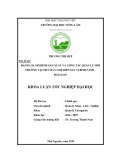



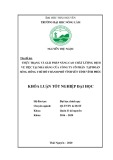

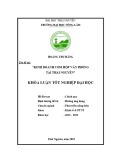

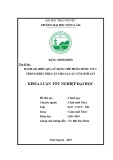
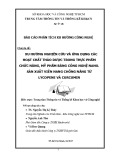



![Bệnh Leptospirosis: Khóa luận tốt nghiệp [Nghiên cứu mới nhất]](https://cdn.tailieu.vn/images/document/thumbnail/2025/20250827/fansubet/135x160/63991756280412.jpg)


